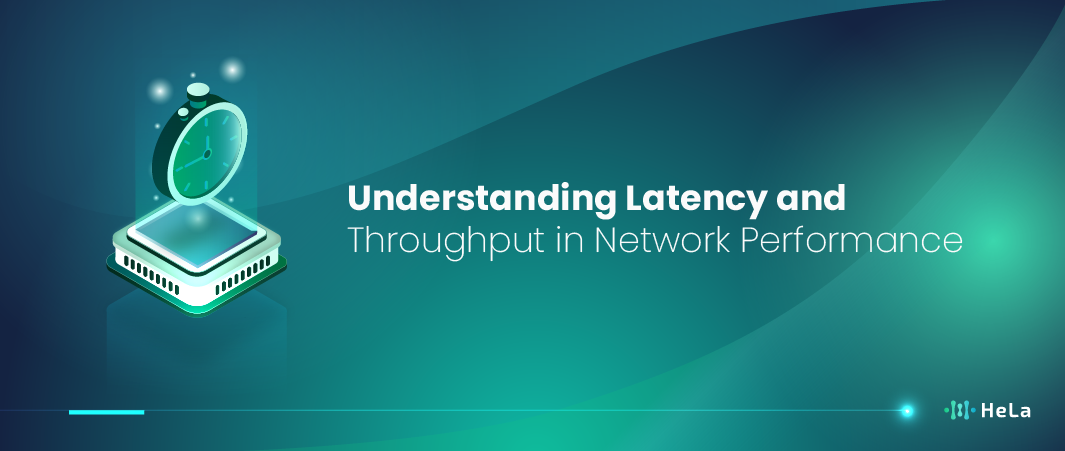The interdependency of latency and throughput is essential in evaluating and enhancing the efficiency of different systems in computer science and network engineering. Latency is the duration it takes for a single item of information to pass through the system from one point to another for instance from the source to the destination. It includes time taken for transmission, processing and querying of data and is expressed in millisecond or microsecond depending on the magnitude of the system. On the other hand, throughput refers to the amount of data that can be transmitted through the network or processed by a system in a given time, typically in terms of bits/second or transactions per second.
Another important characteristic of the dependency between latency and throughput is that they are inversely proportional to one another under specific circumstances. As a rule, a lower latency implies a higher throughput and vice versa. This is due to the fact that when latency is minimized, the time it takes for subsequent data transfer or processing operations is reduced hence more data can be processed or transferred in a given time. Higher throughput on the other hand means that a system can work on more data at the same time which can lower latency by maximizing the utilization of available resources.
Striking the right balance between latency and throughput is not very easy. High throughput systems may cause increased delays resulting from buffering or queuing to handle and manage large volumes of information. These mechanisms can slow down the processing of individual units of data in case of, for instance, heavy traffic or high load rates. On the other hand, decreasing latency by minimizing processing delays may at times reduce overall throughput if it implies resource starvation or suboptimal methods of data management.
Designers and engineers often encounter difficulties in designing and optimizing systems that meet or achieve these important metrics in an optimal manner. The target is to achieve certain applications needs in addition to the expectation of users in terms of response time and data transfer rate. This usually involves analyzing aspects such as system design, network layout, and system and application optimizations specific to the needs of the service or application being offered. Furthermore, technology advances and the emerging trends of a complex computing environment have always challenged the existing system designs and implementation methodologies in terms of latency and throughput bounds.
Latency: The Measure of Delay

Delay, which is commonly called latency, remains as one of the core measures in the field of digital communication networks. It describes the level of delay observed in the communication of data from one point to another, and plays a central role in determining the interaction and speed of different applications and services in the Internet and other networked systems. It is imperative to understand latency in various fields, including telecommunications, computer networking, online games, video streaming, financial transactions, and more.
In its simplest form, latency measures the time difference between the initiation of a request or an action and the time when the corresponding reply is received at the target. This delay can originate from several factors operating in the transmission path of the system. Physical distance plays a significant role, there exists higher propagation delay for data that covers a longer distance, no matter the speed at which they are transmitted, through mediums such as fiber optic cables. Furthermore, a wired or wireless transmission medium influences latency due to signal transmission and interference.
In the context of complex network architectures, latency can be further subdivided into a range of subtypes. Propagation delay means the time taken by the signal to cover the physical media, which depends mainly on the distance between the transmitter and the receiver. Transmission delay on the other hand involves the time needed to push all bits of a packet into the communication link. Delay is experienced at each network device (routers, switches, etc. ) as they read packet headers, make decisions about packet forwarding, and do computations. Last but not least, queuing delay occurs when packets queue up in the buffer for transmission because of network congestion or priority queuing algorithms.
Also Read: What Is Staking? A Comprehensive Guide
Both the control and minimization of latency is a paramount goal in reaching the best possible network and user performance. Some applications that include interactivity in real-time, including gaming, video conferencing, and VoIP, need a minimal amount of delay to allow for immediate interaction. Measures to address latency include innovations in technology and improvement of networks. Some of these are to use faster hardware, tuning routing protocols to minimize the number of hops and inefficiencies, activating QoS to prioritize ‘real-time’ traffic, and using content delivery networks (CDNs) to cache data more locally, closer to the user base.
By location of computational resources closer to users and through decentralized processing, edge computing and evolution of 5G networks will reduce latency even more in the future. Edge computing, for instance, makes it possible to perform vital computations using servers that are close to the source of data or the user, and this eliminates the delays that central cloud systems introduce. Likewise, 5G networks incorporate a lower latency by increasing the data transmission rates and decreasing the network traffic that hinders the data exchange for applications that require almost immediate responses.
latency is an inherent property of digital communication systems. However, consistent technical advancements and appropriate approaches keep progressing to achieve great performance. Awareness and efficient management of latency are central to not only improving user experience across a broad range of applications but also propelling progress in areas where real-time data transfer is a matter of survival. With the ever development of networks, coupled with the increased need for faster and more responsive networks, the search for low latency will forever remain a work in progress in today’s world.
Throughput: The Measure of Bandwidth

The concept of throughput is very crucial in analyzing the actual efficiency of the data transmission through networks. While bandwidth can indicate the maximum data transfer rate that a network can support, throughput offers a more realistic general on the amount of data that can be transferred in real conditions. It is in bits per second (bps), often in multiples like Mbps or Gbps, which represents the number of data packets successfully transmitted from one point to another in a given time period.
The importance of throughput is that it shows the real working capacity of a network. While bandwidth is the maximum data carrying capacity, throughput takes into account weight issues such as congestion, overhead, and hardware that define the data transfer rates. In other words, high bandwidth does not necessarily translate to high throughput when the network environment is unfavorable or when there are constraints that limit the data rate.
Throughput management includes various approaches and techniques used in enhancing the data transfer rate. iPerf, NetFlow or Wireshark are examples of tools to compare and measure throughput by emulating traffic and comparing it to actual delivered speed. They assist network administrators in diagnosing problems like packet loss, increased latency, and other factors that affect network throughput.
The importance of keeping the traffic to a level that is optimal is paramount especially when providing network dependent applications and services. To increase the rate of data transfer, it is possible to improve the network topology, configure routing, use QoS management and adjust bandwidth usage. Through constant optimization of throughput, enterprises are able to improve the overall usability for their users as well as satisfy the requirements of business critical applications and services in the era of big data and information overload.
Therefore, bandwidth determines the capability while throughput quantifies the outcomes in realistic situations. By directing efforts and resources towards enhancing the throughput, by managing the network well and using the right tools then an organization can enhance the strength of its network in supporting its operations as well as enhance the quality experience of the end user.
The Relationship Between Latency and Throughput

The relationship between latency and throughput is fundamental in understanding the performance and efficiency of systems, especially in computing and networking contexts. Latency refers to the time it takes for a single unit of data to travel from one point to another, often measured in milliseconds or microseconds. It encompasses factors such as processing delay, transmission delay, and propagation delay. In contrast, throughput refers to the rate at which data is successfully transferred from one place to another within a given timeframe, typically measured in bits per second (bps) or packets per second (pps).
A key aspect of their relationship lies in their inverse correlation under certain conditions. Lower latency generally allows for faster transmission of individual data units, which can lead to higher throughput. This is because reduced latency means less waiting time between data transmissions, enabling more data to be processed and transferred over a specific period. Conversely, higher latency can constrain throughput as delays in processing or transmission can bottleneck the flow of data, reducing the overall rate at which data can be transferred.
Also Read: Top 7 Crypto Wallet Companies to Consider in 2024
However, achieving high throughput does not always necessitate low latency, and vice versa. Systems can be optimized to prioritize one over the other based on specific requirements and constraints. For instance, in real-time applications like online gaming or video conferencing, low latency is crucial to minimize delays and provide a seamless user experience. On the other hand, in bulk data transfer scenarios such as file downloads, high throughput is often prioritized over low latency since the focus is on transferring large amounts of data efficiently, even if individual latency for each packet might be higher.
Furthermore, advancements in technology and network infrastructure continuously influence the relationship between latency and throughput. Innovations such as faster processors, improved networking protocols, and optimized data transmission techniques can help reduce latency and increase throughput simultaneously.
Balancing these factors effectively is essential for designing efficient systems that meet the performance demands of modern applications, ensuring both responsive user experiences and efficient data handling capabilities. Thus, understanding and managing the interplay between latency and throughput is crucial for optimizing the performance and reliability of computing and communication systems across various domains.
Conclusion
The relationship between latency and throughput in computing systems is crucial for understanding overall system performance. Latency refers to the time it takes for a single unit of data to travel from one point to another within a system, often measured in milliseconds or even microseconds. It directly impacts user experience, especially in interactive applications where delays can be noticeable and affect usability. On the other hand, throughput represents the rate at which data can be processed or transferred within the system, typically measured in bytes per second or transactions per second. While latency focuses on the delay for individual units of data, throughput provides a broader view of how efficiently a system handles overall workload.
In practical terms, these two metrics are intertwined but can exhibit complex dynamics. Lower latency generally correlates with higher throughput, as reducing the time between requests or operations allows the system to process more tasks in a given timeframe. However, achieving optimal performance requires balancing both metrics, as optimizing for one may inadvertently affect the other. For instance, increasing throughput by parallelizing tasks might introduce higher latency due to coordination overhead. Therefore, a nuanced approach is necessary in system design and optimization to strike the right balance between minimizing latency for responsiveness and maximizing throughput for overall efficiency. Understanding and managing the relationship between latency and throughput is essential for designing robust, high-performance computing systems capable of meeting diverse application requirements effectively.
Disclaimer: The information provided by HeLa Labs in this article is intended for general informational purposes and does not reflect the company’s opinion. It is not intended as investment advice or a recommendation. Readers are strongly advised to conduct their own thorough research and consult with a qualified financial advisor before making any financial decisions.

